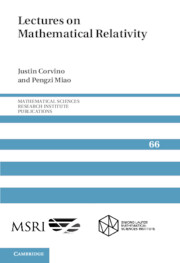Book contents
- Frontmatter
- Dedication
- Contents
- Preface
- Notation and conventions
- Chapter 1 Special relativity and Minkowski spacetime
- Chapter 2 The Einstein equation
- Chapter 3 Basics of Lorentzian causality
- Chapter 4 The Penrose singularity theorem
- Chapter 5 The Einstein constraint equations
- Chapter 6 Scalar curvature deformation and the Einstein constraint equations
- Chapter 7 Asymptotically flat solutions of the Einstein constraint equations
- Chapter 8 On the center of mass and constant mean curvature surfaces of asymptotically flat initial data sets
- Chapter 9 On the Riemannian Penrose inequality
- References
- Index
Chapter 9 - On the Riemannian Penrose inequality
Published online by Cambridge University Press: 03 April 2025
- Frontmatter
- Dedication
- Contents
- Preface
- Notation and conventions
- Chapter 1 Special relativity and Minkowski spacetime
- Chapter 2 The Einstein equation
- Chapter 3 Basics of Lorentzian causality
- Chapter 4 The Penrose singularity theorem
- Chapter 5 The Einstein constraint equations
- Chapter 6 Scalar curvature deformation and the Einstein constraint equations
- Chapter 7 Asymptotically flat solutions of the Einstein constraint equations
- Chapter 8 On the center of mass and constant mean curvature surfaces of asymptotically flat initial data sets
- Chapter 9 On the Riemannian Penrose inequality
- References
- Index
Summary
In 1973 Roger Penrose proposed an inequality which states that, in an isolated gravitational system with nonnegative local energy density, the total mass of the system must be at least as much as that contributed by any black holes contained within. The original motivation for proposing the inequality is the fact that a counterexample of this inequality would produce a counterexample for the cosmic censorship conjecture. While the Penrose inequality in full generality remains an open problem, we present in this chapter the main ideas of three proofs of the Riemannian Penrose inequality, a special case that arises in the time-symmetric setting. In this setting, the Penrose inequality is formulated on an asymptotically flat manifold with nonnegative scalar curvature that contains closed minimal surfaces, and asserts a bound of the total mass in terms of the area of the outermost minimal surface. We begin with Lam's proof for the graphical case, then move to the inverse mean curvature flow approach of Huisken and Ilmanen, and finish with a sketch of Bray's conformal flow technique.
- Type
- Chapter
- Information
- Lectures on Mathematical Relativity , pp. 357 - 382Publisher: Cambridge University PressPrint publication year: 2025

